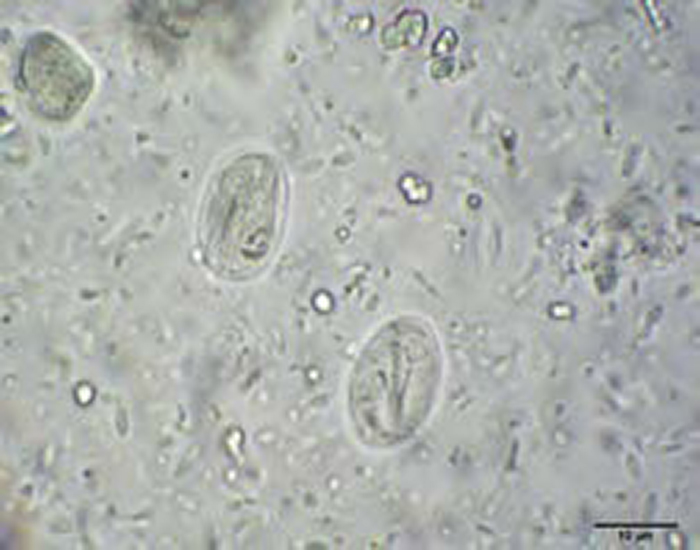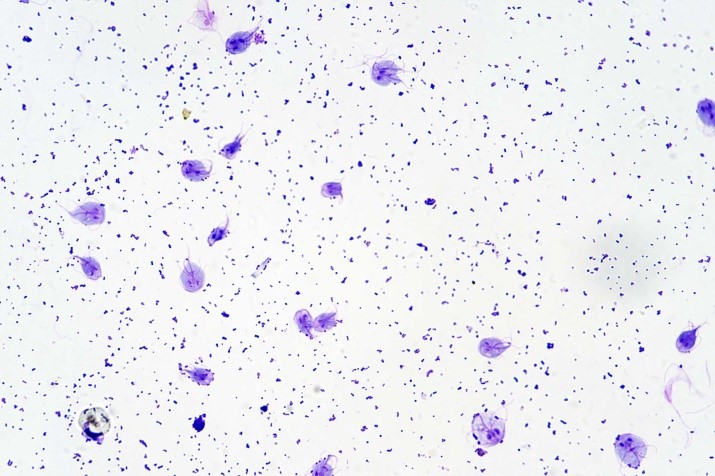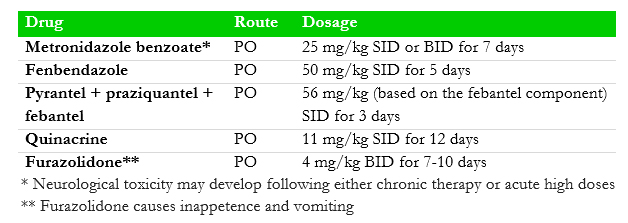Giardia
(Giardia duodenalis)
Giardia spp. are flagellated intestinal protozoa that can infect a wide range of wild and domestic animals, including cats. Some genetic assemblages are zoonotic.
Distribution
Worldwide.
Clinical signs
The most common clinical sign of G. duodenalis infection in cats is diarrhoea. Some cats may present vomiting, weight loss, and kittens may fail to gain weight. Faeces tend to be soft and pale in colour [1]. Adults cats are usually asymptomatic.

Figure 1. Giardia duodenalis cysts on centrifugal faecal flotation (Image credit: Dr. T. Inpankaew)

Figure 2. Stained faecal smear displaying Giardia duodenalis binucleate trophozoites in cat faeces (Image credit: Shutterstock)
Diagnosis
Giardia duodenalis infection in cats can be confirmed by centrifugal faecal flotation using zinc sulfate solution with a SG of 1.18 (SOP 2) for the detection of cysts (approximately 7.4 x 10.5 μm) (Fig. 1). A direct wet fresh faecal smear examination from cats with diarrhoea may reveal the presence of motile ‘tumbling’ or ‘falling leaf’ trophozoites (~10.5-17.5 x 5.25-8.75 μm) (Fig. 2), but these need to be differentiated from Tritrichomonas foetus. A direct immunofluorescence assay containing monoclonal antibodies that react with Cryptosporidium oocysts and Giardia cysts in faeces (Merifluor Cryptosporidium/Giardia direct immunofluorescence assay, Meridian Laboratories) is commercially available. Commercial enzyme-linked immunosorbent assays (ELISAs) are also widely available for the detection of Giardia coproantigens, including point-of-care tests (e.g. SNAP Giardia Test, IDEXX Laboratories). PCR for the detection and quantification of Giardia DNA is also considered extremely sensitive and is offered by commercial labs in some countries.
Treatment
For antiprotozoal treatment options, refer to Table 3.
Table 3. Routes of administration, dosage and efficacies of commonly utilised drugs against G. duodenalis infection in cats [2,3].
Prevention and Control
The most effective way to control Giardia infection is by treating all cats in the household or cattery at the same time and practicing high standards of environmental hygiene. For cats that appear unresponsive to treatment, the potential for re-infection should be considered.
Public health considerations
Although assemblage A of G. duodenalis is zoonotic, cats are primarily infected with assemblage F and therefore not considered to play a role in the transmission of Giardia to humans.
References
[1] Bowman DD, Hendrix CM, Lindsay DS, Barr SC. Feline Clinical Parasitology. Iowa State University Press, Ames, USA. 2002.
[2] Scorza AV and Lappin MR. Metronidazole for the treatment of feline giardiasis. Journal of Feline Medicine and Surgery (2004) 6, 157–160.
[3] Tangtrongsup S, Scorza V. Update on the diagnosis and management of Giardia spp infections in dogs and cats. Top Companion Anim Med. 2010;25(3):155-62.

